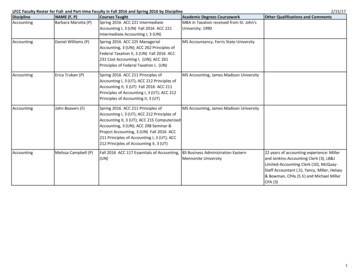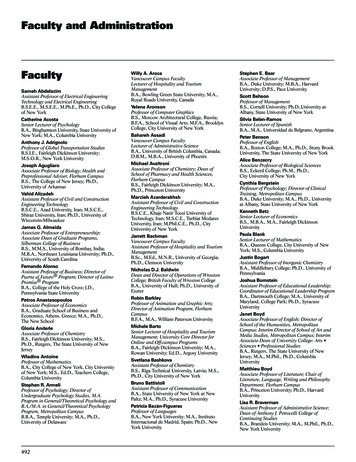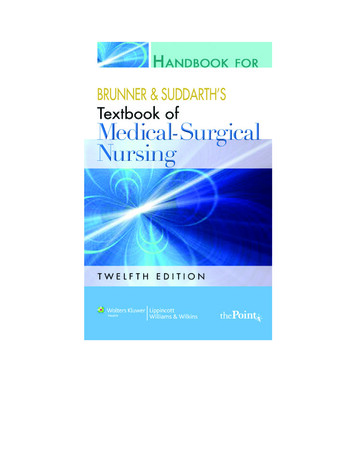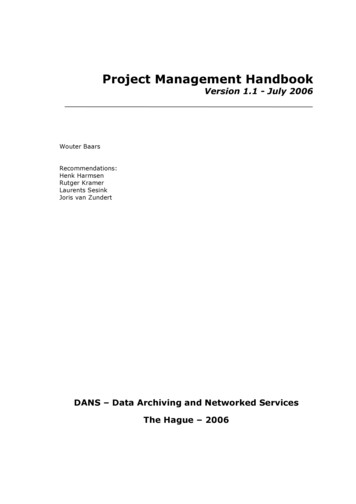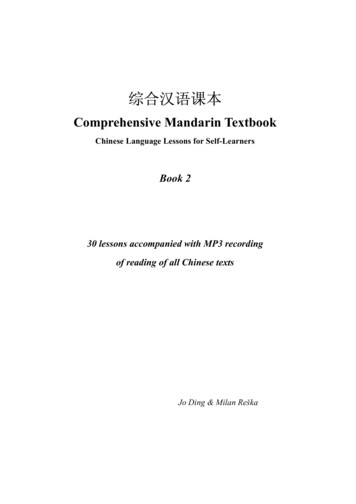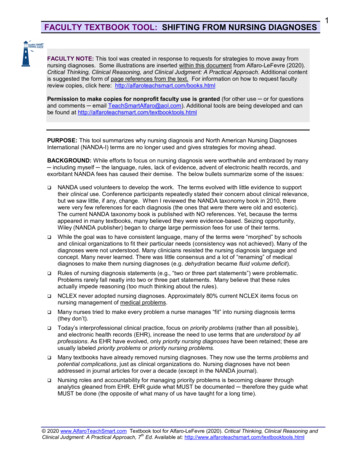
Transcription
FACULTY TEXTBOOK TOOL: SHIFTING FROM NURSING DIAGNOSESFACULTY NOTE: This tool was created in response to requests for strategies to move away fromnursing diagnoses. Some illustrations are inserted within this document from Alfaro-LeFevre (2020).Critical Thinking, Clinical Reasoning, and Clinical Judgment: A Practical Approach. Additional contentis suggested the form of page references from the text. For information on how to request facultyreview copies, click here: http://alfaroteachsmart.com/books.htmlPermission to make copies for nonprofit faculty use is granted (for other use or for questionsand comments email TeachSmartAlfaro@aol.com). Additional tools are being developed and canbe found at OSE: This tool summarizes why nursing diagnosis and North American Nursing DiagnosesInternational (NANDA-I) terms are no longer used and gives strategies for moving ahead.BACKGROUND: While efforts to focus on nursing diagnosis were worthwhile and embraced by many including myself the language, rules, lack of evidence, advent of electronic health records, andexorbitant NANDA fees has caused their demise. The below bullets summarize some of the issues: NANDA used volunteers to develop the work. The terms evolved with little evidence to supporttheir clinical use. Conference participants repeatedly stated their concern about clinical relevance,but we saw little, if any, change. When I reviewed the NANDA taxonomy book in 2010, therewere very few references for each diagnosis (the ones that were there were old and esoteric).The current NANDA taxonomy book is published with NO references. Yet, because the termsappeared in many textbooks, many believed they were evidence-based. Seizing opportunity,Wiley (NANDA publisher) began to charge large permission fees for use of their terms. While the goal was to have consistent language, many of the terms were “morphed” by schoolsand clinical organizations to fit their particular needs (consistency was not achieved). Many of thediagnoses were not understood. Many clinicians resisted the nursing diagnosis language andconcept. Many never learned. There was little consensus and a lot of “renaming” of medicaldiagnoses to make them nursing diagnoses (e.g. dehydration became fluid volume deficit). Rules of nursing diagnosis statements (e.g., “two or three part statements”) were problematic.Problems rarely fall neatly into two or three part statements. Many believe that these rulesactually impede reasoning (too much thinking about the rules). NCLEX never adopted nursing diagnoses. Approximately 80% current NCLEX items focus onnursing management of medical problems. Many nurses tried to make every problem a nurse manages “fit” into nursing diagnosis terms(they don’t). Today’s interprofessional clinical practice, focus on priority problems (rather than all possible),and electronic health records (EHR), increase the need to use terms that are understood by allprofessions. As EHR have evolved, only priority nursing diagnoses have been retained; these areusually labeled priority problems or priority nursing problems. Many textbooks have already removed nursing diagnoses. They now use the terms problems andpotential complications, just as clinical organizations do. Nursing diagnoses have not beenaddressed in journal articles for over a decade (except in the NANDA journal). Nursing roles and accountability for managing priority problems is becoming clearer throughanalytics gleaned from EHR. EHR guide what MUST be documented therefore they guide whatMUST be done (the opposite of what many of us have taught for a long time). 2020 www.AlfaroTeachSmart.com Textbook tool for Alfaro-LeFevre (2020). Critical Thinking, Clinical Reasoning andthClinical Judgment: A Practical Approach, 7 Ed. Available at: 1
FACULTY TEXTBOOK TOOL: SHIFTING FROM NURSING DIAGNOSESSTRATEGIES Recognize that it takes an initial shift in thinking from old nursing diagnosis habits, but once youdo it, it totally makes sense. Replace the term nursing diagnosis with priority nursing and medical problems that the nursemust manage (see pages 3-5 of this document). Use the terms used on NCLEX and in local EHRand decision support tools. If the problems are not clearly defined, use the term issue. Here’s anexample of 4 priority problems a patient may have that require nursing management, in additionto the standard priorities (e.g., safety, infection control, medication management, patientparticipation, communication, immobility, and monitoring for and signs and symptoms of potentialcomplications): pneumonia, dehydration risk, fatigue, pain.Note that reason for admission is always a priority, while others may change daily, based onindividual patient needs. Interventions aimed at treating pneumonia include treating many of theold nursing diagnoses, such as Ineffective Airway Clearance. Make safety, infection control, and medication reconciliation first priority in every patient situation(teach these on day ONE). Note that medication reconciliation is a priority issue, but not anursing diagnosis. See Quick Priority Assessment, textbook pages 106 - 107. Be sure learners know how to determine their own scope of practice (page 6 of this document),as well as their roles and responsibilities in relation to specific problems (see NursingAccountability What Do Nurses Do, textbook pages 84-89). NCSBN stresses that not knowingscope of practice is no excuse for errors. It doesn’t matter whether the problem is a nursing ormedical diagnosis; what matters is nursing accountability for each patient problem. Make identification of potential complications a requirement (pages 3-5 of this document). Focus on prevention and health promotion (see Predict, Prevent, Manage, Promote Model,textbook pages 105-107) Ensure that learners identify all the factors contributing to the priority problems, both medical andnursing. (see “Systematic Problem Analysis Worksheet” on textbook page 162) Focus on QSEN and JCAHO standards and priorities. For example, patient communication,education, and satisfaction; error prevention and teamwork. Stress assessment and monitoring role. A major priority must be to identify signs and symptoms(cues) that indicate need for more expert evaluation. Teach problem-focused assessment and intervention: What is the nursing management of theproblems listed on pages 3-5 of this document? Giving them the big picture, as on pages 3-5 issimilar to giving them the NANDA list of diagnoses. If you use concept-based curriculum, consider whether your concepts may replace some of thenursing diagnoses (e.g., “The priority patient issues were oxygenation and mobility”). Teach principles of clinical reasoning (textbook pages 80-83) Pay attention to how technology influences clinical judgment (see free 30 minute tml) Use a map to ensure holistic assessment (see textbook page 91; also athttp://alfaroteachsmart.com/textbooktools.html) Keep what you know is working. For example, Gordon’s Functional Health Patterns remainuseful for holistic nursing assessment. Maslow is helpful for setting priorities. Remember that ifyou’re using only one approach, you are probably not thinking critically. It takes severalapproaches. Telling students something like, “here’s another way of looking at this” is good. Finally: Help your students become critical thinkers (it’s the foundation for building reasoningskills and helps them deal with the constant change they will experience in school and the clinicalsetting. Chapter 2, Becoming a Critical Thinker, is devoted to this. 2020 www.AlfaroTeachSmart.com Textbook tool for Alfaro-LeFevre (2020). Critical Thinking, Clinical Reasoning andthClinical Judgment: A Practical Approach, 7 Ed. Available at: 2
FACULTY TEXTBOOK TOOL: SHIFTING FROM NURSING DIAGNOSESTextbook page 87 (inserting textbook image was problematic; this is my handout).Common Priority Nursing Problems (Alphabetical List)NOTE: Depending on problem complexity and nurse qualifications, nurses are accountable forconsulting with primary care providers before determining a plan of care. This is a partial list; adaptas needed. Activity Intolerance / Mobility problemsAirway and breathing problemsBehavioral problems managementComfort / pain managementConstipation, diarrhea, and other bowelelimination problemsDehydration risksHealth promotionInfection / safety / fall risk managementMedication and other treatmentmanagementNutrition problemsOral hygiene † Urinary elimination problemsPatient educationPressure ulcer/impaired skin integrity riskmanagementSelf-care problems (feeding, bathing,dressing, toileting, other ADLs)Sleep problemsSmoking cessation,Spiritual ConcernsSurveillance (monitoring to detectreportable signs and symptoms)Violence or self-harm risksWeight management† Linked with pneumonia incidence 2020 www.AlfaroTeachSmart.com Textbook tool for Alfaro-LeFevre (2020). Critical Thinking, Clinical Reasoning andthClinical Judgment: A Practical Approach, 7 Ed. Available at: 3
FACULTY TEXTBOOK TOOL: SHIFTING FROM NURSING DIAGNOSESTextbook page 88 (inserting textbook image was problematic; this is my handout).COMMON MEDICAL PROBLEMS AND THEIR POTENTIAL COMPLICATIONS*ANGINA / MYOCARDIAL INFARCTION.DysrhythmiasCongestive Heart Failure / Pulmonary EdemaShock (cardiogenic, hypovolemic)Infarction, infarction extensionThrombi / emboli formation (pulmonary emboli, stroke)HypoxemiaElectrolyte imbalanceAcid-base imbalancePericarditisCardiac tamponadeCardiac arrestSee also Kidney DiseaseLUNG DISEASES (ASTHMA, COPD, ETC. ).HypoxemiaAcid-base and electrolyte imbalanceRespiratory FailureInfectionSee also Pneumonia and Angina / Myocardial InfarctionPNEUMONIA.Respiratory FailureDehydrationSepsis / septic shockPulmonary embolusPulmonary hypertensionSee also Angina / Myocardial InfarctionDIABETES.Hypoglycemia (Diabetic Shock)Hyperglycemia (Diabetic Coma)Compromised Circulation – Pressure and leg ulcersDelayed wound healingHypertensionEye problems (retinal hemorrhage)InfectionDehydrationSee also Angina / Myocardial Infarction and Kidney FailureHYPERTENSION.Stroke (Cerebrovascular accident-CVA)Transient ischemic attacks (TIAs)Hypertensive crisisSee also Angina / Myocardial infarction and Kidney FailureURINARY TRACT INFECTION (UTI).Septic shockKidney FailureHIV AND IMMUNOSUPRESSIONOpportunistic infections (TB, herpes,intestinal organisms, etc)Severe diarrheaSee also lung diseases and pneumoniaFRACTURES.Bleeding (internal or external)Bone fragment displacementEdema / pressure pointsCompromised circulationNerve compressionCompartment syndromeThrombus / embolus formationInfectionHEAD TRAUMA.Respiratory depressionAirway occlusionAspirationBleeding (internal or external)ShockBrain swellingIncreased intracranial pressureSeizures-ComaHyper / hypothermiaInfectionOTHER TRAUMA.See Anesthesia / Surgical invasive procedures,next box.DEPRESSION / PSYCHIATRIC DISORDERSReality distortionDehydration - MalnutritionSuicideViolence (against self or others)Self-protection problemsTrauma-deathMedication side effectsKIDNEY DISEASE.Congestive Heart FailureKidney FailureEdemaHyperkalemiaElectrolyte / acid-base imbalanceAnemiaSee also Hypertension and Urinary Tract Infection 2020 www.AlfaroTeachSmart.com Textbook tool for Alfaro-LeFevre (2020). Critical Thinking, Clinical Reasoning andthClinical Judgment: A Practical Approach, 7 Ed. Available at: 4
FACULTY TEXTBOOK TOOL: SHIFTING FROM NURSING DIAGNOSESTextbook page 89 (inserting textbook image was problematic; this is my handout)COMMON COMPLICATIONS RELATED TO TREATMENTS AND INVASIVE PROCEDURESANESTHESIA – SURGICAL PROCEDURES:Respiratory depressionAirway management problemsAspirationAtelectasis-pneumoniaBleeding (internal or external)Hypovolemia / shockInfection / septic shockFluid/electrolyte imbalanceThrombus / embolusParalytic ileusUrinary retentionIncision complications (infection, poor healing,dehiscence/evisceration)See also Angina / Myocardial Infarction, previous box.CARDIAC CATHETERIZATION-INVASIVE MONITORING:Bleeding (internal or at insertion site)Hemo-pneumothoraxThrombus / embolus formationStrokeInfection / sepsisSee also Angina/Myocardial Infarction, previous boxCHEST TUBES - THORACENTESIS:Bleeding (internal or at insertion site)Hemo-pneumothoraxAtelectasisChest tube malfunction/blockageInfection / sepsisFOLEY CATHETER:Infection / sepsisCatheter malfunction/blockageBladder spasmsIV THERAPY:Bleeding (internal or at insertion site)Air embolusPhlebitis / thrombophlebitisInfiltration / extravasation / tissue necrosisFluid overloadInfection / sepsisMEDICATIONS:Adverse reactions (allergic response, exaggeratedresponse, side effects)Drug interactionsOverdose / toxicityNASOGASTRIC SUCTION:Electrolyte imbalanceTube :Bleeding (internal or at insertion site)Paralytic ileusInfection / sepsis.SKELETAL TRACTION / CASTS:See fractures, previous box 2020 www.AlfaroTeachSmart.com Textbook tool for Alfaro-LeFevre (2020). Critical Thinking, Clinical Reasoning andthClinical Judgment: A Practical Approach, 7 Ed. Available at: 5
FACULTY TEXTBOOK TOOL: SHIFTING FROM NURSING DIAGNOSESTextbook page 93 (inserting textbook image was problematic; this is my handout)CLINICAL DECSION-MAKING AND SCOPE OF PRACTICE*THINK about what you plan toassess or to do, then answer thefollowing questions.1. Are You Qualified / Authorized? Allowed by policies, procedures, and job description?Allowed by instructor or supervisor?Have the required knowledge, skill, and experience?Passed competency tests, if needed?Accept accountability for patient response / outcome?2. Is it Sa
Rules of nursing diagnosis statements (e.g., “two or three part statements”) were problematic. Problems rarely fall neatly into two or three part statements. Many believe that these rules actually impede reasoning (too much thinking about the rules). NCLEX never adopted nursing diagnoses. Approximately 80% current NCLEX items focus on nursing management of medical problems . Many





